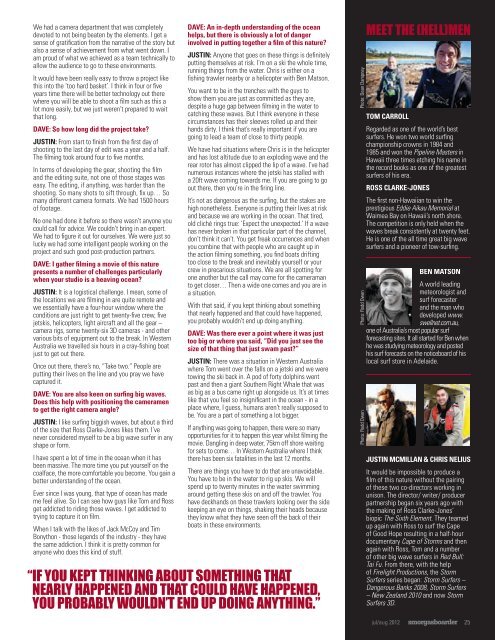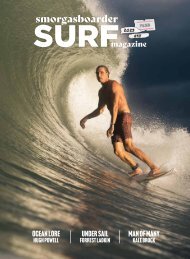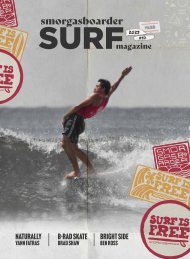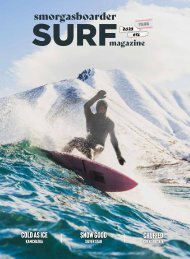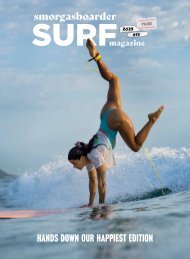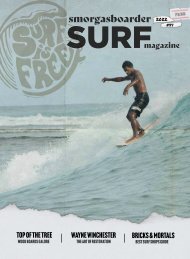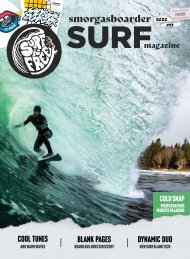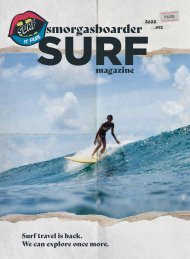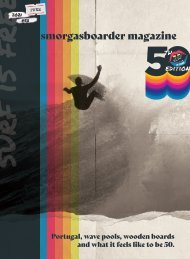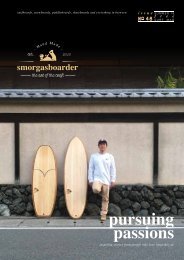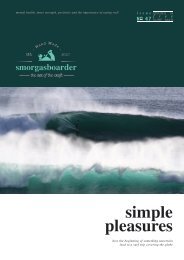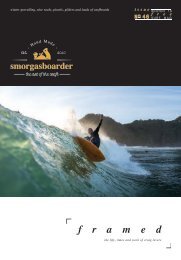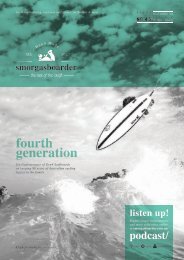Create successful ePaper yourself
Turn your PDF publications into a flip-book with our unique Google optimized e-Paper software.
We had a camera department that was completely<br />
devoted to not being beaten by the elements. I get a<br />
sense of gratification from the narrative of the story but<br />
also a sense of achievement from what went down. I<br />
am proud of what we achieved as a team technically to<br />
allow the audience to go to these environments.<br />
It would have been really easy to throw a project like<br />
this into the ‘too hard basket’. I think in four or five<br />
years time there will be better technology out there<br />
where you will be able to shoot a film such as this a<br />
lot more easily, but we just weren’t prepared to wait<br />
that long.<br />
DAVE: So how long did the project take?<br />
JUSTIN: From start to finish from the first day of<br />
shooting to the last day of edit was a year and a half.<br />
The filming took around four to five months.<br />
In terms of developing the gear, shooting the film<br />
and the editing suite, not one of those stages was<br />
easy. The editing, if anything, was harder than the<br />
shooting. So many shots to sift through, fix up… So<br />
many different camera formats. We had 1500 hours<br />
of footage.<br />
No one had done it before so there wasn’t anyone you<br />
could call for advice. We couldn’t bring in an expert.<br />
We had to figure it out for ourselves. We were just so<br />
lucky we had some intelligent people working on the<br />
project and such good post-production partners.<br />
DAVE: I gather filming a movie of this nature<br />
presents a number of challenges particularly<br />
when your studio is a heaving ocean?<br />
JUSTIN: It is a logistical challenge. I mean, some of<br />
the locations we are filming in are quite remote and<br />
we essentially have a four-hour window where the<br />
conditions are just right to get twenty-five crew, five<br />
jetskis, helicopters, light aircraft and all the gear –<br />
camera rigs, some twenty-six 3D cameras - and other<br />
various bits of equipment out to the break. In Western<br />
Australia we travelled six hours in a cray-fishing boat<br />
just to get out there.<br />
Once out there, there’s no, “Take two.” People are<br />
putting their lives on the line and you pray we have<br />
captured it.<br />
DAVE: You are also keen on surfing big waves.<br />
Does this help with positioning the cameramen<br />
to get the right camera angle?<br />
JUSTIN: I like surfing biggish waves, but about a third<br />
of the size that Ross Clarke-Jones likes them. I’ve<br />
never considered myself to be a big wave surfer in any<br />
shape or form.<br />
I have spent a lot of time in the ocean when it has<br />
been massive. The more time you put yourself on the<br />
coalface, the more comfortable you become. You gain a<br />
better understanding of the ocean.<br />
Ever since I was young, that type of ocean has made<br />
me feel alive. So I can see how guys like Tom and Ross<br />
get addicted to riding those waves. I get addicted to<br />
trying to capture it on film.<br />
When I talk with the likes of Jack McCoy and Tim<br />
Bonython - those legends of the industry - they have<br />
the same addiction. I think it is pretty common for<br />
anyone who does this kind of stuff.<br />
DAVE: An in-depth understanding of the ocean<br />
helps, but there is obviously a lot of danger<br />
involved in putting together a film of this nature?<br />
JUSTIN: Anyone that goes on these things is definitely<br />
putting themselves at risk. I’m on a ski the whole time,<br />
running things from the water. Chris is either on a<br />
fishing trawler nearby or a helicopter with Ben Matson.<br />
You want to be in the trenches with the guys to<br />
show them you are just as committed as they are,<br />
despite a huge gap between filming in the water to<br />
catching these waves. But I think everyone in these<br />
circumstances has their sleeves rolled up and their<br />
hands dirty. I think that’s really important if you are<br />
going to lead a team of close to thirty people.<br />
We have had situations where Chris is in the helicopter<br />
and has lost altitude due to an exploding wave and the<br />
rear rotor has almost clipped the lip of a wave. I’ve had<br />
numerous instances where the jetski has stalled with<br />
a 20ft wave coming towards me. If you are going to go<br />
out there, then you‘re in the firing line.<br />
It’s not as dangerous as the surfing, but the stakes are<br />
high nonetheless. Everyone is putting their lives at risk<br />
and because we are working in the ocean. That tired,<br />
old cliché rings true: ‘Expect the unexpected.’ If a wave<br />
has never broken in that particular part of the channel,<br />
don’t think it can’t. You get freak occurrences and when<br />
you combine that with people who are caught up in<br />
the action filming something, you find boats drifting<br />
too close to the break and inevitably yourself or your<br />
crew in precarious situations. We are all spotting for<br />
one another but the call may come for the cameraman<br />
to get closer… Then a wide one comes and you are in<br />
a situation.<br />
With that said, if you kept thinking about something<br />
that nearly happened and that could have happened,<br />
you probably wouldn’t end up doing anything.<br />
DAVE: Was there ever a point where it was just<br />
too big or where you said, “Did you just see the<br />
size of that thing that just swam past?”<br />
JUSTIN: There was a situation in Western Australia<br />
where Tom went over the falls on a jetski and we were<br />
towing the ski back in. A pod of forty dolphins went<br />
past and then a giant Southern Right Whale that was<br />
as big as a bus came right up alongside us. It’s at times<br />
like that you feel so insignificant in the ocean - in a<br />
place where, I guess, humans aren’t really supposed to<br />
be. You are a part of something a lot bigger.<br />
If anything was going to happen, there were so many<br />
opportunities for it to happen this year whilst filming the<br />
movie. Dangling in deep water, 75km off shore waiting<br />
for sets to come… In Western Australia where I think<br />
there has been six fatalities in the last <strong>12</strong> months.<br />
There are things you have to do that are unavoidable.<br />
You have to be in the water to rig up skis. We will<br />
spend up to twenty minutes in the water swimming<br />
around getting these skis on and off the trawler. You<br />
have deckhands on these trawlers looking over the side<br />
keeping an eye on things, shaking their heads because<br />
they know what they have seen off the back of their<br />
boats in these environments.<br />
“ IF YOU KEPT THINKING ABOUT SOMETHING THAT<br />
NEARLY HAPPENED AND THAT COULD HAVE HAPPENED,<br />
YOU PROBABLY WOULDN’T END UP DOING ANYTHING.”<br />
Photo: Rodd Owen Photo: Rodd Owen Photo: Dean Dampney<br />
MEET THE (HELL)MEN<br />
TOM CARROLL<br />
Regarded as one of the world’s best<br />
surfers. He won two world surfing<br />
championship crowns in 1984 and<br />
1985 and won the Pipeline Masters in<br />
Hawaii three times etching his name in<br />
the record books as one of the greatest<br />
surfers of his era.<br />
ROSS CLARKE-JONES<br />
The first non-Hawaiian to win the<br />
prestigious Eddie Aikau Memorial at<br />
Waimea Bay on Hawaii’s north shore.<br />
The competition is only held when the<br />
waves break consistently at twenty feet.<br />
He is one of the all time great big wave<br />
surfers and a pioneer of tow-surfing.<br />
BEN MATSON<br />
A world leading<br />
meteorologist and<br />
surf forecaster<br />
and the man who<br />
developed www.<br />
swellnet.com.au,<br />
one of Australia’s most popular surf<br />
forecasting sites. It all started for Ben when<br />
he was studying meteorology and posted<br />
his surf forecasts on the noticeboard of his<br />
local surf store in Adelaide.<br />
JUSTIN MCMILLAN & CHRIS NELIUS<br />
It would be impossible to produce a<br />
film of this nature without the pairing<br />
of these two co-directors working in<br />
unison. The director/ writer/ producer<br />
partnership began six years ago with<br />
the making of Ross Clarke-Jones’<br />
biopic The Sixth Element. They teamed<br />
up again with Ross to surf the Cape<br />
of Good Hope resulting in a half-hour<br />
documentary Cape of Storms and then<br />
again with Ross, Tom and a number<br />
of other big wave surfers in Red Bull:<br />
Tai Fu. From there, with the help<br />
of Firelight Productions, the Storm<br />
Surfers series began: Storm Surfers –<br />
Dangerous Banks 2008, Storm Surfers<br />
– New Zealand 2010 and now Storm<br />
Surfers 3D.<br />
jul/aug 20<strong>12</strong><br />
25


